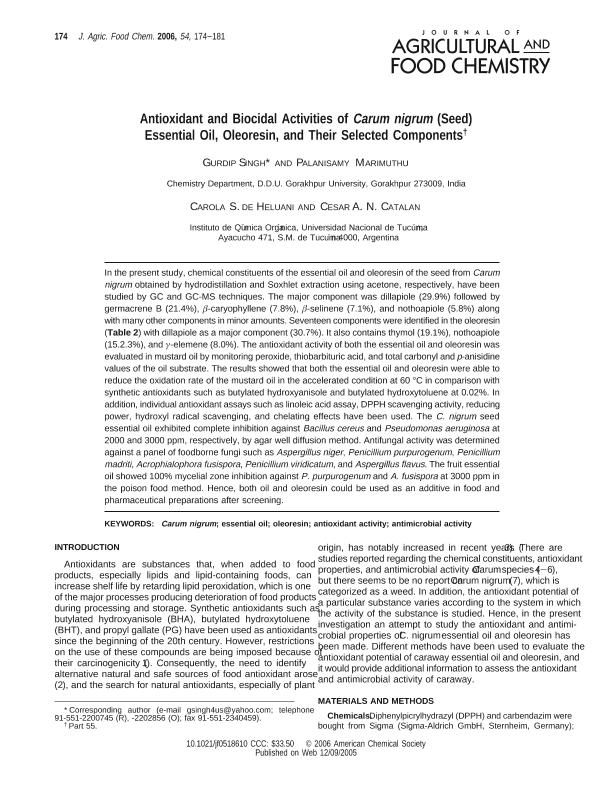Artículo
Antioxidant and biocidal activities of Carum nigrum (Seed) essential oil, oleoresin, and their selected components
Fecha de publicación:
01/2006
Editorial:
American Chemical Society
Revista:
Journal of Agricultural and Food Chemistry
ISSN:
0021-8561
Idioma:
Inglés
Tipo de recurso:
Artículo publicado
Clasificación temática:
Resumen
In the present study, chemical constituents of the essential oil and oleoresin of the seed from Carum nigrum obtained by hydrodistillation and Soxhlet extraction using acetone, respectively, have been studied by GC and GC-MS techniques. The major component was dillapiole (29.9%) followed by germacrene B (21.4%), β-caryophyllene (7.8%), β-selinene (7.1%), and nothoapiole (5.8%) along with many other components in minor amounts: Seventeen components were identified in the oleoresin (Table 2) with dillapiole as a major component (30.7%). It also contains thymol (19.1%), nothoapiole (15.2.3%), and γ-elemene (8.0%). The antioxidant activity of both the essential oil and oleoresin was evaluated in mustard oil by monitoring peroxide, thiobarbituric acid, and total carbonyl and p-anisidine. values of the oil substrate. The results showed that both the essential oil and oleoresin were able to reduce the oxidation rate of the mustard oil in the accelerated condition at 60°C in comparison with synthetic antioxidants such as butylated hydroxyanisole and butylated hydroxytoluene at 0.02%. In addition, individual antioxidant assays such as linoleic acid assay, DPPH scavenging activity, reducing power, hydroxyl radical scavenging, and chelating effects have been used. The C. nigrum seed essential oil exhibited complete inhibition against Bacillus cereus and Pseudomonas aeruginosa at 2000 and 3000 ppm, respectively, by agar well diffusion method. Antifungal activity was determined against a panel of foodborne fungi such as Aspergillus niger, Penicillium purpurogenum, Penicillium madriti, Acrophialophora fusispora, Penicillium viridicatum, and Aspergillus flavus. The fruit essential oil showed 100% mycelial zone inhibition against P. purpurogenum and A. fusispora at 3000 ppm in the poison food method. Hence, both oil and oleoresin could be used as an additive in food and pharmaceutical preparations after screening. © 2006 American Chemical Society.
Archivos asociados
Licencia
Identificadores
Colecciones
Articulos(INQUINOA)
Articulos de INST.DE QUIMICA DEL NOROESTE
Articulos de INST.DE QUIMICA DEL NOROESTE
Citación
Singh, Gurdip; Marimuthu, Palanisamy; De Heluani, Carola S.; Catalan, Cesar Atilio Nazareno; Antioxidant and biocidal activities of Carum nigrum (Seed) essential oil, oleoresin, and their selected components; American Chemical Society; Journal of Agricultural and Food Chemistry; 54; 1; 1-2006; 174-181
Compartir
Altmétricas




